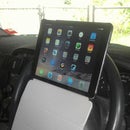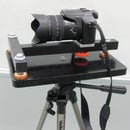Introduction: Super Specs - 3D and Much More
The title for this Instructable was really hard to pick because these Super Specs have so many uses.
So many uses? Let’s list a few:
* 3D stereo glasses that will work on any screen that uses passive split polarity for 3D regardless of brand.
(Will not work for electronic switched 3D stereo.)
* 3D stereo glasses that work with any color code of anaglyph (common type of color coded stereo image).
* Preview a scene so you can see how it will look when you later photograph with a filter.
* Magnifying glasses with a whole range of magnifications.
* Sunglasses with any shade of darkness or color you like.
* Exploit the extended sensitivity of human vision to see infra red light.
* Protect your eyes from UV or just about any wavelength of light.
* Have different things happening with each eye.
All this and more from one pair of glasses by simply screwing in your favorite filters in a few seconds. Moreover you can make a pair of these quite cheaply in about an hour if you already have the parts.
OK, OK there is a little catch; to achieve all this you are going to have to get various camera filters to use in your Super Specs. I can guess you are thinking “Oh Oh! This is going to be expensive.” But there is a way to get a whole range of cool camera filters that are very cheap and will still work on your camera too: get them on eBay and try clicking that box so you can search worldwide; what you need are the Chinese suppliers. I have bought polarizers for as little as $3 and you can often get bundles of mixed camera filters for less than $20 all brand new.
Having said that I guess it will be no surprise that I bought everything for this project on eBay. Even though I did the purchasing some months ago, I have done fresh search to get prices for the parts list (including postage). Your mileage will vary depending on patience and luck finding bargains.
To attach the filters to the lenses so that they can be easily unscrewed and changed I glued two lens adapter rings into the glasses frames.
(Please vote for me, I would really like to win the Epilog laser cutter. Thanks)
Step 1: Step 1, What You Will Need:
Listed below are the parts you need together. It pays to be patient and wait for bargains. Get the glasses first and measure them to determine the size of the adapter rings and filters. I was lucky, my first pair of "Ga Ga"s were just the right size for 52mm-55mm adapter rings and my camera filter collection for my FZ50 are all 55mm.
If you plan to screw in heavy filters or lenses (for example fisheye lenses) then you may need a glasses frame strap to keep them on your face.
Parts List:
One pair of “Lady Ga Ga” fashion glasses or other glasses with large circular framed lenses. ($13.20)
Two lens adapter rings to fit the glasses. ($1.82 each)
At least one pair of filters to start. eg. 2 circular polarizers at $6.18 each.
Some metal/plastic adhesive (eg. 5 minute Araldite) (You only need a tiny amount.)
So all up less than $30 or much less if you have filters already for your camera.
Tools:
Miniature (Jeweler’s) screwdrivers
Dish of boiling water
Step 2: Step 2, Modifying the Glasses:
To get the glasses ready you only have to get the lenses out. Did I say "only" this was actually the hardest part of the whole job. Usually the lenses are just plastic on these cheap copies. Take the arms off the glasses so you won’t break them while removing the lenses, and store the tiny screws somewhere safe.
If you are not reasonably rugged when it comes to handling hot things then some water proof gloves might be useful for the next part.Also test the frames in hot water first mine didn't soften in hot water but the lenses did. Your frames and lenses may be made from different plastics.If so you might have to use a different method than below.
Place the frame into a dish of boiling hot water. When the plastic lenses are soft enough take the frame out of the water and use a flat blade jeweler’s screwdriver carefully to start the lens coming out of the frame. Then re-heat the frame back in the boiling hot water and push the lenses out of the frame with your fingers; it isn’t easy, so be patient and careful.
I guess if you are expert with a tool like a Dremel you might be able to just cut the lenses in pieces but I never tried that (I saved my lenses for another project).
Step 3: Step 3, Final Assembly
Dry the frame and test the rings in the frame to make sure the male thread will fit where the lens was and that the step behind the female thread will support the ring.
Then glue the adapter rings into the frame making sure you have the female thread pointing to the front. It is a nice touch to make sure that the labels are at the top of the glasses. Use just enough glue to do the job.
After the glue has set reattach the arms to the frame and you have finished your Super Specs. Screw in your first pair of filters and try them out.
Step 4: Step 4, Using Your Super Specs
In the photos you might notice I have used circular polarizers (CPL); I also have linear polarizers and I think they work better for 3D glasses but they are harder to find. The manufactures of 3D TVs use different polarization angles from brand to brand. Most camera polarization filters have the ability to rotate to any angle so you can adjust each lens to suit the screen you are viewing.
Test out your polarizers by looking at an ordinary LCD screen, closing one eye and rotate the polarizer for the open eye until the screen goes black; repeat with the other eye. Eerie eh?? Now rock your head a little and you will see your screen appear and disappear. To tune them for a 3D screen is a similar one eye at a time deal, but you turn the lenses to get a clear image in each eye. If the 3D image doesn't look 3D you may have both lenses at the same angle, try rotating one lens by 90 degrees and try again. If the image sort of looks 3D but not quite right you may have switched left and right if so rotate each filter about 90 degrees and try again.
When you are using filters for photography you can first put the filter you are planning to use in one side of the Super Specs and look at your subject. It is very convenient to experiment by opening and closing each eye to see the effect and how the shot will look even before you get out the camera, tripod etc. You can even rapidly compare two filters to make a selection.
Other filters to try:
* You can buy macro lenses in sets of 4 (+1, +2, +4, +10) for $20 delivered. These make excellent magnifying glasses and you can combine them in different ways because they have both male and female threads.
* An extremely large range of colored filters are available.
* You can also buy IR filters that block visible light and pass IR. When deprived of what we normally think of as visible light your eyes can become more sensitive to IR. Because these glasses let light in the sides they are not perfect for this use but will work to some degree with 720nm IR filters (eg. Hoya 720) when looking out from the dark to the light eg. looking out a window on a bright sunny day.
See:
http://amasci.com/amateur/irgoggl.html
https://www.instructables.com/id/Homemade-Infrared-Goggles!-For-Under-$10/
You can even roll your own screw in filters as per:
https://www.instructables.com/id/Mod-a-Cokin-P007-to-fit-into-a-screw-in-filter/

Participated in the
3rd Epilog Challenge













